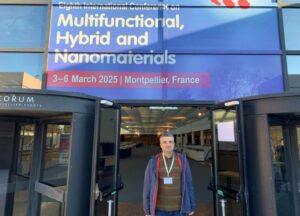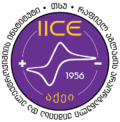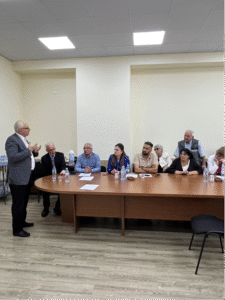The seminar shared impressions from the scientific conference “Multifunctional Hybrid & Nanomaterials” held in Montpellier in March of this year, where, among 49 countries represented, Archil Benashvili, a doctoral student at our institute, presented a poster on behalf of Georgia entitled “Simultaneously electrogenerated manganese and cobalt oxides for potential application as electrode materials for supercapacitors”.
The goal of the work is to produce economically affordable and environmentally safe electrode materials for supercapacitors from manganese and cobalt oxides that will operate more efficiently than their commercially available alternatives.
MnO/CoO/C powder was obtained by electrolysis of 0.4 M MnSO₄, 0.4 M CoSO₄ and 0.5 M Na₂SO₄ solution using graphite working and auxiliary electrodes, using chronoamperometry techniques.
A nickel cloud covered with a monolayer of graphene served as a conductor, while PEDOT (Poly(3,4-ethylenedioxythiophene)-poly(styrenesulfonate)) served as an electron collector. The charge was accumulated in MnxOy/CoxOy/C სტრუქტურაში.
After spin-coating a graphene monolayer nickel cloud with manganese and cobalt oxides and carbon powder, we studied the morphology and composition of the layer. X-ray diffraction (XRD) analysis of the powder shows that the sample is practically amorphous. X-ray fluorescence spectral analysis of the sample shows weak emission of cobalt and relatively strong emission of manganese. Energy-dispersive spectroscopy (EDS) analysis of the sample also shows intense emission of oxygen and carbon. It also revealed other elements – sulfur, silicon, sodium and nickel.
Thermogravimetric analysis showed that CoO₂ converts to CoO� 400;">₃O₄-ad. Co₃O₄ is stable and does not undergo further transformations. At about 530°C, MnO₂ is converted to Mn₂O₃. MnO is stable up to about 800-850°C, and above this temperature it transforms into the MnO form. An increase in mass above about 850°C indicates the ignition of carbon. There is a significant difference in thermogravimetry in the case of commercial MnO₂/Co₃O₄/C powder, as no noticeable mass changes are observed due to the absence of additional components. In this case too, at around 530°C, MnO₂ is converted to Mn₂O₃.
The MnxOy/CoxOy/C composite was obtained by one-step electrogeneration of MnSO₄/CoSO₄/Na₂SO₄ solution using graphite electrodes. The electrochemical properties of the electrode, which consists of a graphene monolayer nickel cloud and PEDOT-bonded MnO/CoO/C, were investigated by cyclic voltammetry (CV) and galvanostatic charge-discharge (GCD) methods in Na₂. 400;">SO₄ in solution.
The specific capacitance of the electrode we fabricated is promising for the development of a supercapacitor electrode. We varied the current and obtained different specific capacitance results, which require improvement in the future compared to the commercial powder-coated electrode.






